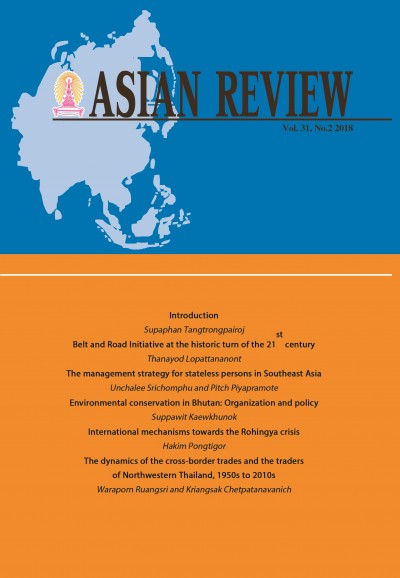Environmental conservation in Bhutan: Organization and policy
Keywords:
Bhutan, Enviromental Conservation, Environmental Policy, Public ParticipationAbstract
This article is about Bhutan's success in conserving natural resources and the environment through its organizational and public policy perspectives. At the same time, it analyses the weaknesses and strengths of Bhutan's policy and organizational management in environmental conservation. The integration of the sustainable development approach and the Mahayana Buddhism philosophy has led to the creation of the Gross National Happiness (GNH) which is an important concept that drives the Bhutan government to pay more attention to environmental protection. The close relationship between the Bhutanese and the environment is in accordance with the old beliefs and the influence of Buddhism has contributed to the successful implementation of the government's environmental policy. In addition, the driving force behind the environmental policy has been to design an organizational structure that promotes public participation in order to truly reflect the problem and contribute to sustainable solutions. Integrating indigenous ideas with international principles and building public participation, which indicates Bhutan's success in driving environmental policy, is an important finding of this work.
References
Asefa, Sisay, ed. 2005. Th e Economics of Sustainable Development. Michigan: W.E. Upjohn Institute for Employment Research.
Centre for Bhutan Studies. 1999. Gross National Happiness Discussion Papers. Thimphu: The Centre for Bhutan Studies.
Coenen, Frans H. J. M. 2009. Public Participation and Better Environmental Decisions: Th e Promise and Limits of Participatory Processes for the Quality of Environmentally Related Decision- Making. Dordrecht: Springer.
Creighton, James L. 2005. Th e Public Participation Handbook: Making Better Decisions through Citizen Involvement. San Francisco: Jossey-Bass.
Dinitzen, H. Bjerreskov and Jensen, L. Krogh. 2010. Organisational Theory: A Practical Approach. Udgave. Kbh: Hans Reitzel.
Dolkar, Jamyang, Dorji, Sherab, Dorji, Tshetrim, Choden, Kinley,Wangmo, Nima and Patel, Samir S. 2013. “Public Awareness of Environmental Policies in Bhutan.” Bhutan Journal of Research & Development: 1-14.
Dunne, Tim, Milja Kurki, and Steve Smith. 2013. International Relations Theories: Discipline and Diversity. Oxford: Oxford University Press.
Economist. “Bhutan Th e pursuit of happiness.” 2004. www.economist.com/ christmas-specials/2004/12/16/the-pursuit-of-happiness.
Fennell, David A. 2015. Ecotourism. 4th edition. New York: Routledge.
Fraser, Neil, Anima Bhattacharya, and Bimalendu Bhattacharya. 2001. Geography of a Himalayan Kingdom: Bhutan. New Delhi: Concept Publishing Company.
Gane, Michael. 2007. Forest Strategy: Strategic Management and Sustainable Development for the Forest Sector. Dordrecht: Springer.
Givel, Michael S. 2015. “Gross National Happiness in Bhutan: Political Institutions and Implementation.” Asian Affairs 46(1): 102-117.
Gross National Happiness Commission. 2013. “Bhutan.” Country Planning Cycle Database a World Health Organization Resource, www.nationalplanningcycles.org/ sites/default/files/countrydocs/Bhutan/ndpbhutan.pdf.
Gupta, B. Sen. 1999. Bhutan towards a Grass-roots Participatory Polity. New Delhi: Konark Publishers PVT LTD.
Kathuria, Anil. 2007. Encyclopaedia of Nepal, Bhutan and Tibet (Bhutan). Delhi: Mehra Off set Press.
Kharat, Rajesh S, ed. 2016. Bhutan: Contemporary Issues and Perspectives. New Delhi: Adroit Publishers.
Ministry of Agriculture and Forests. 2017. “Forest Facts & Figures 2016.” Ministry of Agriculture and Forests, www.dofps.gov.bt/wp-content/ uploads/2017/07/ ForestBookletFinal.pdf.
National Council of Bhutan. 2014. “The Constitution of The Kingdom of Bhutan.” National Council of Bhutan, www.nationalcouncil.bt/assets/ uploads/files/Constitution%20%20of%20Bhutan%20English.pdf.
National Council of Bhutan. 2016. “Review Report on Tourism Policy and Strategies.” National Council of Bhutan, www.nationalcouncil.bt/assets/ uploads/files/ FINAL%20Tourism%20Policy%20EAC%2016th%20 Session.pdf.
National Environment Commission. 2017. “About NEC.” National Environment Commission, www.nec.gov.bt/nec1/index.php/about-nec/.
O’Neill, K. 2009. Th e Environment and International Relations. Cambridge: Cambridge University Press.
Phuntsho, Karma. 2016. Th e History of Bhutan. Haryana: Random House Publishers India Private Limited.
Seshadri, Sudhi. 2005. Sourcing Strategy Principles, Policy and Design. New York: Springer.
Singh, Nagendra. 1972. Bhutan A Kingdom in the Himalayas. New Delhi: Thomson Press (India) Limited.
World Bank. 2017. “World Bank national accounts data, and OECD National Accounts data files.” data.worldbank.org/indicator/NY.GDP. MKTP.CD? locations=BT. World Commission on Environment and Development. 1987. Our Common Future. Oxford: Oxford University Press.
Downloads
Published
How to Cite
Issue
Section
License
Published articles are under the copyright of the Instiute of Asian Studies, Chulalongkorn University. Partially or totally publication of an article elsewhere is possible only after the consent from the editors.







